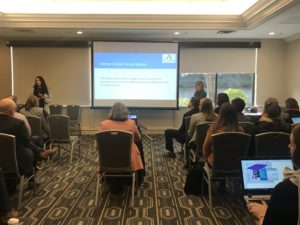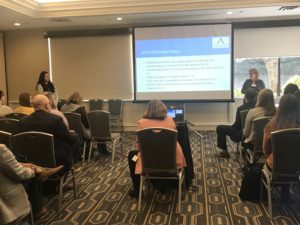
Site Leaders Corrie Marchand and Allison Scanlon present at DESE’s 2019 “Sharing for Success” Dissemination Fair
This month, Atlantis had the privilege of presenting at the Department of Elementary and Secondary Education’s (DESE) “Sharing for Success” D issemination Fair. The state recently recognized Atlantis as a best-practice school in the area of social-emotional learning for its success in decreasing behavioral incidents across all grades K-12.
The Dissemination Fair was held at the Hilton Hotel in Leominster on Friday, November 8. More than 200 educators from schools across the state attended presentations on 15 topics such as re-engaging disengaged learners and recruiting and training diverse and talented teachers. Atlantis Site Leaders Corrie Marchand (K-6) and Allison Scanlon (7-12) joined representatives from two other schools in leading a panel on social-emotional learning at the middle/high school level. They talked about the steps Atlantis took to successfully reduce the number of behavioral incidents from one school year to the next.
During the 2016-2017 school year, 115 (just over 10 percent) of the school’s 1,128 students were disciplined for school safety offenses. The following school year (2017-2018) only 96 students (just under 8 percent) were disciplined while the total student population grew by 104 students. That’s a drop of more than 2 percent in just one year.
“We looked at what we did in the last year that really impacted our school, and determined the primary factor was that we implemented Response to Intervention (RTI) at the high school level,” Marchand explained.
RTI is a multi-tier approach used by schools to identify and support students with learning and behavioral needs. Struggling students are provided with personalized interventions to help them meet academic or behavioral goals. For example, one student may benefit from working with a reading specialist, while another may benefit from seeing a school adjustment counselor. Progress is closely monitored, and interventions are adjusted when necessary to ensure each individual child finds success in the classroom. RTI is common at the elementary level, but it is used less frequently at the high school level.

Site Leaders Corrie Marchand and Allison Scanlon present at DESE’s 2019 “Sharing for Success” Dissemination Fair
“There isn’t always this thought of bringing RTI up to the high school level because people often think that students are at an age where it isn’t going to have a meaningful impact, but we’re seeing the direct opposite,” Scanlon said. “We cannot be of the mindset that because a student is 17 or 18 years old they are equipped to figure everything out on their own – no, they’re still dealing with social-emotional issues for a specific reason and we must get them the support they need so they can be a productive member of our school and society.”
Scanlon says that by high school, most academic issues have been addressed with special education and 504 plans, therefore the majority of RTI plans at the high school level address behavioral concerns. For instance, a student may be unable to sustain in a class without blurting out or may repeatedly ask to leave the room.
“By implementing RTI at the high school level, we were able to put very specific supports in place for students that addressed the root of the problem rather than issuing an in-school or out-of-school suspension,” said Scanlon.
“We want students to reach their long-term goal of graduation,” Marchand added, “so for high school kids who are one or two years out from graduation this is high stakes.
Scanlon talked about the logistical challenges Atlantis had to overcome to implement RTI at the high school. She also discussed the other social-emotional supports Atlantis offers in addition to RTI including 6 full-time adjustment counselors, schoolwide PBIS (Positive Behavior Interventions & Supports), mentoring and advising programs, second step programs, and Dean of Students positions at the lower and upper schools.
Marchand and Scanlon were also able to attend a few other panels at the conference and found the discussions on project-based learning at the elementary, middle and high school levels especially relevant.
“It’s really applicable to what we’re doing in the Career Academies,” Scanlon said. “I got to see what other schools are doing with project-based learning and got some ideas for how we can implement what they’re doing into the Academy model.”
“At the lower grades, project-based learning really increases student engagement by tying the different subject areas together,” Marchand said. “I think it’s a great opportunity to get more accomplished in the short time that we have with our students. Instead of teaching a unit on social studies and another on ELA, you can find creative ways to combine those units.”
Scanlon and Marchand say they are glad to have had the opportunity to attend and present at the Dissemination Fair because these conferences open doors and allow for greater collaboration between schools.
